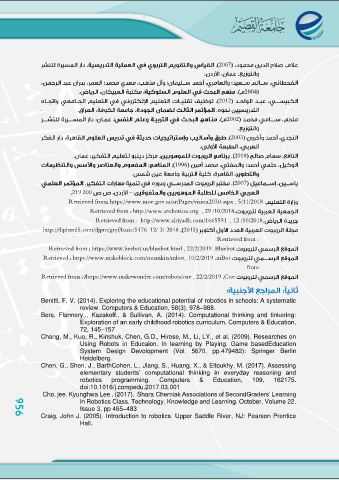Page 673 - Binder2
P. 673
2007
2004
2012
2002
2003
2018
1996
.
2007
219 200 –
Retrieved from https://www.moe.gov.sa/ar/Pages/vision2030.aspx , 5/11/2018
Retrieved from http://www.aroboticsa.org , 29 /10/2018
Retrieved from : http://www.alriyadh.com/1665591 , 12 /10/2018
http://fliphtml5.com/djpm/gryf/basic/5176 12/ 3/ 2018 2015
Retrieved from :
Retrieved from https://www.beebot.us/bluebot.html , 22/2/2019 .Bluebot
Retrieved https://www.makeblock.com/steamkits/mbot, 10/2/2019 mBot
from
Retrieved from https://www.makewonder.com/robots/cue , 22/2/2019 Cue
956 Benitti, F. V. (2014). Exploring the educational potential of robotics in schools: A systematic
review. Computers & Education, 58(3), 978–988.
Bers, Flannery,., Kazakoff., & Sullivan, A. (2014). Computational thinking and tinkering:
Exploration of an early childhood robotics curriculum. Computers & Education,
72, 145–157
Chang, M., Kuo, R., Kinshuk, Chen, G.D., Hirose, M., Li, LY., et al. (2009). Researches on
Using Robots in Educaion. In learning by Playing. Game basedEducation
System Design Devolopment (Vol. 5670, pp.479482): Springer Berlin
Heidelberg.
Chen, G., Shen, J., BarthCohen, L., Jiang, S., Huang, X., & Eltoukhy, M. (2017). Assessing
elementary students’ computational thinking in everyday reasoning and
robotics programming. Computers & Education, 109, 162175.
doi:10.1016/j.compedu.2017.03.001
Cho, jee. Kyunghwa Lee . (2017). Shara Cherniak Associations of SecondGraders’ Learning
in Robotics Class. Technology, Knowledge and Learning. October, Volume 22,
Issue 3, pp 465–483
Craig, John J. (2005). Introduction to robotics. Upper Saddle River, NJ: Pearson Prentice
Hall.
956

